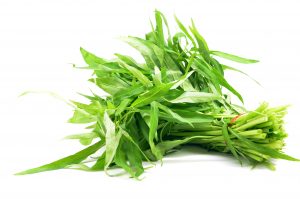 Scientific name: Ipomoea aquatica
Scientific name: Ipomoea aquatica
Usage
Medicinal Uses
Water spinach, or kangkong has a long history of traditional medicine use, with the stems being determined as more potent than the leaves. The plant is rich in minerals such as calcium and iron, and contains sodium, magnesium, phosphorous, manganese, copper, and zinc. Vitamin B2, C, and K are also present. Further active ingredients include flavonoids, catechin and phenolic compounds, so there is powerful antioxidant activity. Research has indicated that there is significant medicinal value in the Kang Kong plant, with studies on cholesterol and diabetic treatments being explored.
In Ayurveda, it is used to treat jaundice and liver problems. The leaves are used to treat diabetes in pregnant women and it is also used as a sedative to promote sleep and relaxation.
Culinary Uses
Kangkong has many culinary uses with recipes available from all over Southeast Asia. The plant is used extensively in Burmese, Thai, Lao, Cambodian, Taiwanese, Malaysian, Vietnamese, and Chinese cooking. Some parts of China and South East Asia cultivate kangkong for commercial use and sale in local markets.
Kangkong may be used in the same way as spinach and other Asian greens by adding the leaves to salads, stir fry dishes, and vegetable dishes. For example, the leaves may be cooked in olive oil for a few minutes and combined with garlic and chilli. The young leaf tips or the stems are also used as an alternative to green leafy vegetables. The leaves have a mild flavour and may be eaten raw or cooked.
Country of Origin
Kangkong originated from tropical Asia, most likely India. It is now widespread throughout South and Southeast Asia, tropical Africa, South and Central America, and Oceania. The vegetable is quite common in Southeast Asia, Hong Kong, Taiwan, and in southern China, but is most popular in South and Southeast Asia (AVRDC, 2019).
Time to harvest
The first harvest date of nutritious water spinach is usually 4 to 6 weeks after planting – depending more on the temperature and growing conditions. Cut only a few leaves or the entire plant with leaves and stems leaving only 3 inch of growth, and the plant will regrow (Roger, 2019).
Share with:

